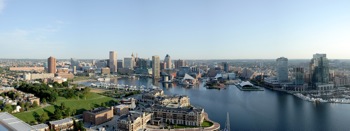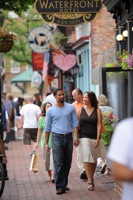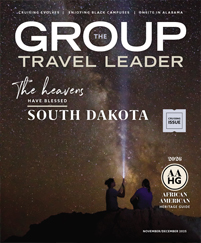 Courtesy Baltimore CVB
Courtesy Baltimore CVB
Along history with an active downtown harbor has made Baltimore one of the most bustling cities in the Mid-Atlantic region. But unlike some other East Coast metropolises, built up with towering skyscrapers, Baltimore’s architectural aesthetic hearkens back to its industrial past.
“Baltimore is very good at taking old, abandoned warehouses that were used in the 1950s and reusing them,” said Nancy Hinds, vice president of public affairs for Visit Baltimore. “That’s what really gives Baltimore its personality, because you don’t have a bunch of high rises that all look the same.”
Baltimore’s personality can be found in a series of downtown neighborhoods that hug the waterfront and reflect various phases of the city’s past. From the round-the-clock energy of Inner Harbor to the arts district of Mount Vernon and the cobblestone streets of Fells Point, these downtown neighborhoods all offer a distinct facet of the visitor experience.
Inner Harbor
Many of Baltimore’s most famous tourist attractions can be found in Inner Harbor, a neighborhood in the center of the city that helped to spur a local renaissance when it was developed in the 1980s.
“Inner Harbor is really the crown jewel of the city,” Hinds said. “The waterfront is the centerpiece of everything. All our hotels are right along the waterfront, and most of our attractions are right along the waterfront, so you can really walk everywhere.”
 |
| Courtesy Baltimore CVB |
Some of the city’s biggest attractions are in Inner Harbor, including the stadiums where the Baltimore Orioles and the Baltimore Ravens play baseball and football, respectively. Traditional museums in the area include the Maryland Science Center and the Baltimore Aquarium, which features 16,000 creatures from around the world, as well as a 35-foot-high indoor waterfall.
Another interesting attraction in Inner Harbor is Geppi’s Entertainment Museum, which is housed inside historic Camden Station.
“It’s a train station that Abraham Lincoln passed through,” Hinds said. “It’s been transformed into a pop culture museum by a Diamond Comics distributor who had a collection of pop culture items. He opened this museum with all of these icons, from 60 years ago to present day.”
Harbor East
Though the development of Inner Harbor helped to re-energize part of downtown 30 years ago, a new project at the beginning of this century brought life to an abandoned area that is contiguous to Inner Harbor. This neighborhood, now known as Harbor East, is one of the hottest destinations in the city.
“Harbor East didn’t exist 10 years ago,” Hinds said. “But in 2001, we opened a new Marriott Waterfront on what was a vacant stretch of land. It transformed the whole area from old warehouses and abandoned properties, and has become one of the most popular neighborhoods in Baltimore.”
Today Harbor East is a booming mixed-use neighborhood. Visitors will find a variety of restaurants, cafes and shops scattered among the buildings, which also house hotels, offices and loft condos.
Harbor East is connected to Inner Harbor by a brick-paved promenade, which stretches seven miles around the city’s waterfront.
Fells Point
The promenade continues from Harbor East into the neighborhood of Fells Point, where the architecture recalls a time from Baltimore’s earlier history.
“Fells Point is an old, historic neighborhood with row houses,” Hinds said. “It has cobblestone streets, because it was the center of maritime activity in the 1700s and early 1800s, and they didn’t ever rip the streets up.”
The neighborhood was once the country’s second-busiest entry point for immigrants after Ellis Island and is still a hub of waterborne transportation. Groups can watch tugboats going in and out of the port there or catch a water taxi to other parts of the city. One tourism company, Urban Pirates, offers cruises on a replica pirate ship for groups and allows them to participate in sailing the ship as part of the crew.
The Broadway Pier has become a centerpiece of Fells Point. This historic pier building was renovated by a local developer to house a boutique hotel and a number of shops and restaurants.
Mount Vernon Place
A short trip away from the harbor area, the neighborhood of Mount Vernon has blossomed into the local hotspot for arts and culture.
“Way back when, Mount Vernon was considered the countryside for the wealthy people of Baltimore,” Hinds said. “So it has old Victorian houses, and it has really become our cultural hub.”
The neighborhood is home to the Walters Art Museum, which houses a collection of art that was collected by brothers William and Henry Walters and then bequeathed to the city of Baltimore. The collection spans the history of art around the world, including pieces from ancient Egypt, Greek sculpture, art-deco jewelry and paintings by Europe’s Old Masters.
Not far away, the Station North Arts District is home to modern artists.
“The city really wanted to encourage artists to take over, live in and work out of a lot of the spaces in the buildings that were empty,” Hinds said. “So it has become a hub for artists, and it’s been a great success.”
While in Mount Vernon, groups can also visit Baltimore’s Washington Monument. This 178-foot landmark was the first monument in the country built in honor of George Washington.










